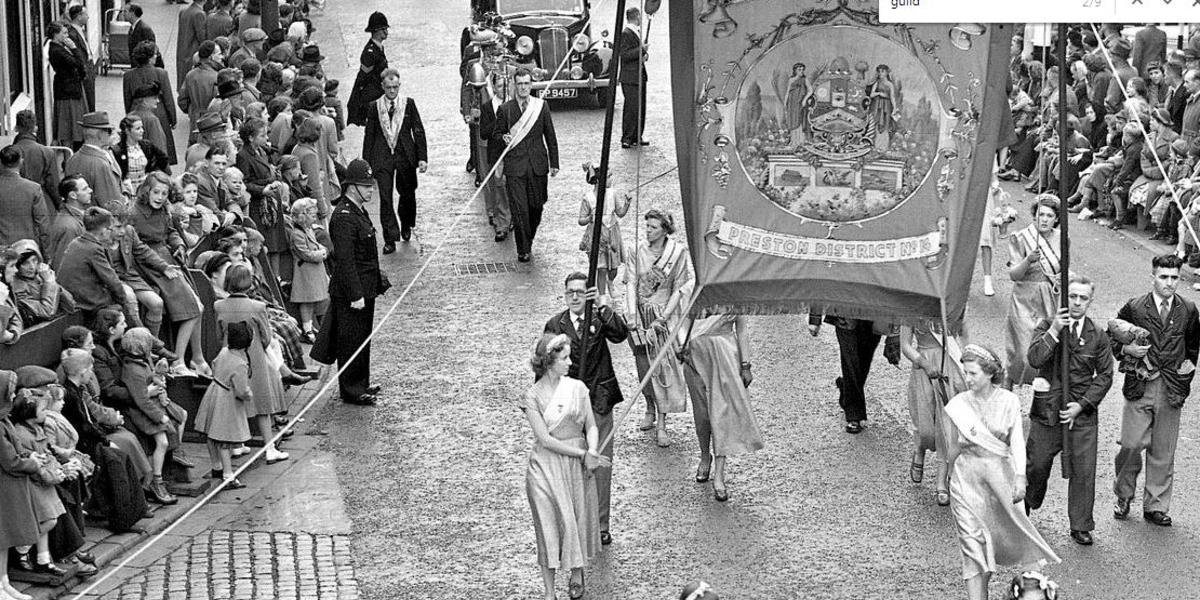Guild Procession History
Developing into a prestigious occasion for feasting and social gatherings, the Guild has seen a rich variety of processions. For five centuries the Guild Merchant controlled trade in Preston. It was not until 1790 that there was freedom of trade in the town, despite this, the celebrations had grown into a much-loved tradition of Preston and the Guild continued.
Trades Procession
Trade has always been at the very heart of the Guild, with the first procession of traders, craftsmen and merchants dating back to at least 1762.
Traditionally, these processions were held to demonstrate the power of the Guild. Traders and craftsmen wore colourful costumes and carried banners and emblems of their trades.
By the late 18th century the displays became increasingly elaborate and decorated platforms started to emerge, which became the predecessors of modern floats seen today.
Some trades, such as the carpenters and butchers, have always been in the Guild and others are more recent. In 1802, the cotton industry was involved for the first time. By the end of the 19th century, it had become so important in the life of Preston that it had its own procession.
Last century, as the cotton trades declined in relative importance, new trades appeared. In the Guilds of 1972 and 1992 industries represented in the processions included nuclear power, mail order catalogues, electronics and aircraft building.
Church, School and Community Processions
In 1835, the Corporation (council at the time) was reformed and the powers of the Guild abolished. As many Guild officers were members of the Corporation, the future of the Guild looked in jeopardy, but strong public pressure ensured its continuation. Inevitably, the nature of the Guild changed. It became a celebration for Preston as a whole - not just the traders and leaders of society. As a result, churches and schools were given their own processions.
Church Procession
The tradition for Church processions goes back to 1842, a relatively short time in Guild terms.
To begin with, the church processions were not an entirely harmonious affair. Intense religious rivalry meant that the Anglican, Catholic and Nonconformist churches held separate processions until 1972 when the first joint event took place.
As the years passed, like the trades processions, those of the churches reflected change in the town and, in particular, the fact that Preston had become a multicultural community. As a result, in 1952 the Ukrainians and Poles, who had come to the town after World War II, were represented in the procession. In 1972, The Gujarat Hindu Society was also represented.
In 1992 the ecumenical movement was strong and the Churches all processed together in two processions. This was divided only by the geographical location of the churches. In total, there were 114 floats, 30 bands, and 8,000 walkers, representing 88 churches.
Community Procession
Evidence that the Guild had become less elite could be seen in the procession of the children of the town, which soon became a favourite with the crowds. Equally popular were the great historical pageants performed by local children in Avenham Park - a tradition which began in 1922.
In 1992 the first ever Community procession took place. This was a great opportunity for the Community as a whole to participate in the Guild celebrations. Around 2,000 people representing 78 groups from schools, the voluntary sector, charities, communities, sports clubs, youth and uniformed groups all took part. Eleven bands provided the music to accompany the 82 imaginatively decorated floats and walkers in elaborate costumes.
Torchlight Procession
The torchlight procession was born in 1882 when hundreds of masked and costumed people weaved their way through the streets with flaming torches illuminating their path.
In 1992 the Torchlight Procession drew the biggest crowds of the week. Around 250,000 people were richly rewarded with a spectacular moving show of music, light, colour, drama and fun. This involved 1650 walkers and 96 floats representing 178 diverse organisations, accompanied by 20 bands.









